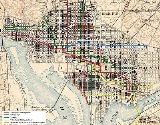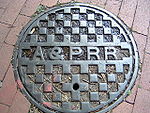
Anacostia and Potomac River Railroad
Encyclopedia
The Anacostia and Potomac River Railroad Company was the fourth streetcar company to operate in Washington, D.C. and the first to cross the Anacostia River. It was chartered in 1870, authorized by Congress in 1875 and built later that year. The line ran from the Arsenal (now Fort McNair) to Union Town (now Historic Anacostia). It expanded, adding lines to Congressional Cemetery, Central Market and to the Government Hospital for the Insane; and in the late 1890s it purchased two other companies and expanded their lines. It was reluctant to change its operations, but in 1900 it relented to pressure and became the last company to switch from horse cars to electric streetcars. It was one of the few companies not to be swept up by the two major streetcar companies at the turn of the 20th century, but it could not hold out forever and on August 31, 1912, it was purchased by the Washington Railway and Electric Company
and ceased to operate as a unique entity.
 The Anacostia and Potomac River Railroad was chartered on May 5, 1870, given approval by Congress on February 18, 1875 and constructed across the Anacostia River later that year. The streetcars traveled from the Arsenal, along M Street SW/SE and 11th Street SE, and crossed the Navy Yard Bridge to Uniontown (now Historic Anacostia). The route then led down Nichols Avenue SE (now Martin Luther King Avenue) to V Street SE where a car barn and stables were maintained by the company.
The Anacostia and Potomac River Railroad was chartered on May 5, 1870, given approval by Congress on February 18, 1875 and constructed across the Anacostia River later that year. The streetcars traveled from the Arsenal, along M Street SW/SE and 11th Street SE, and crossed the Navy Yard Bridge to Uniontown (now Historic Anacostia). The route then led down Nichols Avenue SE (now Martin Luther King Avenue) to V Street SE where a car barn and stables were maintained by the company.
along 11th Street SE and G Street SE, and past Garfield Park to the Center Market (now the National Archives
) in downtown. It completed the expansion later that year. At the same time it was permitted to expand along Nichols Avenue past the Government Hospital for the Insane (now St. Elizabeths Hospital
) to the District boundary, though it only made it as far as Alabama Avenue SE.
The next year, on June 24, 1898 the Anacostia and Potomac River continued its expansion by purchasing
the Belt Railway
and extended its 11 Street line from F street NW to Florida Avenue NW. In 1899 it purchased the Capital Railway.
 In the 1890s and early 20th century most of the Washington, D.C. streetcars came under the control of the Capital Traction Company
In the 1890s and early 20th century most of the Washington, D.C. streetcars came under the control of the Capital Traction Company
or the Washington Railway and Electric Company
. The Anacostia and Potomac River, though initially involved, avoided being purchased during this period. Nonetheless, on August 31, 1912 the Washington Railway purchased the controlling stock of the Anacostia and Potomac River and it ceased to run as a separate company.
Washington Railway and Electric Company
The Washington Railway and Electric Company was the larger of the two major street railway companies in Washington, D.C., the capital of the United States, until 1933. At that time, it was merged with its main competitor, the Capital Traction Company, to form the Capital Transit Company...
and ceased to operate as a unique entity.
Origins

Expansion
On August 1, 1888 the railroad was permitted to expand from the Navy Yard to Congressional CemeteryCongressional Cemetery
The Congressional Cemetery is a historic cemetery located at 1801 E Street, SE, in Washington, D.C., on the west bank of the Anacostia River. It is the final resting place of thousands of individuals who helped form the nation and the city of Washington in the early 19th century. Many members of...
along 11th Street SE and G Street SE, and past Garfield Park to the Center Market (now the National Archives
National Archives and Records Administration
The National Archives and Records Administration is an independent agency of the United States government charged with preserving and documenting government and historical records and with increasing public access to those documents, which comprise the National Archives...
) in downtown. It completed the expansion later that year. At the same time it was permitted to expand along Nichols Avenue past the Government Hospital for the Insane (now St. Elizabeths Hospital
St. Elizabeths Hospital
St. Elizabeths Hospital is a psychiatric hospital operated by the District of Columbia Department of Mental Health. It was the first large-scale, federally-run psychiatric hospital in the United States. Housing several thousand patients at its peak, St. Elizabeths had a fully functioning...
) to the District boundary, though it only made it as far as Alabama Avenue SE.
The next year, on June 24, 1898 the Anacostia and Potomac River continued its expansion by purchasing
Mergers and acquisitions
Mergers and acquisitions refers to the aspect of corporate strategy, corporate finance and management dealing with the buying, selling, dividing and combining of different companies and similar entities that can help an enterprise grow rapidly in its sector or location of origin, or a new field or...
the Belt Railway
Capitol, North O Street and South Washington Railway
The Capitol, North O Street and South Washington Railway was a street railway company in Washington, D.C. from 1875 to 1898. It was the sixth and final company to start during the horse car era. It operated on a loop, or "belt", around downtown and the National Mall. For that reason, and because of...
and extended its 11 Street line from F street NW to Florida Avenue NW. In 1899 it purchased the Capital Railway.
Switch to Electric Power
The company finally switched from horses to electric in April 1900. It was the last horse drawn streetcar to run in the District. ImageThe End of the Line

Capital Traction Company
The Capital Traction Company was the smaller of the two major street railway companies in Washington, D.C. in the early 20th Century. It was formed through a merger of the Rock Creek Railway and the Washington and Georgetown Railroad Company in 1895. The company ran streetcars from Georgetown;...
or the Washington Railway and Electric Company
Washington Railway and Electric Company
The Washington Railway and Electric Company was the larger of the two major street railway companies in Washington, D.C., the capital of the United States, until 1933. At that time, it was merged with its main competitor, the Capital Traction Company, to form the Capital Transit Company...
. The Anacostia and Potomac River, though initially involved, avoided being purchased during this period. Nonetheless, on August 31, 1912 the Washington Railway purchased the controlling stock of the Anacostia and Potomac River and it ceased to run as a separate company.

